Numerical Simulation Investigation on Fracture Propagation of Fracturing for Crossing Coal Seam Roof
Abstract
:1. Introduction
2. Mathematical Model
2.1. Multi-Fracture Propagation Model for Multi-Cluster Fracturing
2.1.1. Rock Deformation Model
2.1.2. Flow Equation of Fluid in the Hydraulic Fracture
2.1.3. Equation of Fluid Flow in the Wellbore
2.1.4. Initial and Boundary Conditions
2.2. Solution Method of the Model
3. Results and Analysis
3.1. In Situ Stress Profiles
3.1.1. “High–Low–High” In Situ Stress Profile
3.1.2. “Low–High–Low” In Situ Stress Profile
3.1.3. “Low–Middle–High” In Situ Stress Profile
3.1.4. “High–Medium–Low” In Situ Stress Profile
3.2. Effect of Fracture Toughness
3.3. Fluid Loss Coefficient
3.4. Fracturing Fluid Viscosity
3.5. Perforation Number in Each Cluster
4. Conclusions
Author Contributions
Funding
Institutional Review Board Statement
Informed Consent Statement
Data Availability Statement
Acknowledgments
Conflicts of Interest
Nomenclature
| pf | Fluid pressure in the fracture, Pa; |
| σh | Minimum horizontal principal stress, Pa; |
| C | Green’s function; |
| t | Time, s; |
| A(t) | The area of opened fractures at time t, m2; |
| A | The area of opened fractures, m2; |
| w | Fracture width, m; |
| (x’, y’, z’) | Source point, (x, y, z)—field point; |
| E | Young’s modulus, Pa; |
| v | Poisson’s ratio, dimensionless; |
| q | Unit length volume flow vector, m2/s; |
| μ | Fluid viscosity, Pa·s; |
| qx | Volume flow per unit length in the x direction, m2/s; |
| qy | Volume flow per unit length in the y direction, m2/s; |
| Cl | Carter’s leak off coefficient, m/s0.5; |
| Qk | The inlet flow of the kth fracture, m3/s; |
| δ | Dirac function, m−2; |
| t0 | The moment when the element is opened, s; |
| nf | The number of fractures; |
| (xin,k, yin,k, zin,k) | The position of the kth fracture; |
| pw | Wellbore pressure, Pa; |
| pt,k | Wellbore flow friction of the kth fracture, Pa; |
| pp,k | Perforation friction of the kth cluster, Pa; |
| pin,k | Inlet pressure of the kth cluster, Pa; |
| ρ | Fracturing fluid density, kg/m3; |
| nk | The number of perforations of the kth cluster; |
| dk | The perforation diameter of the kth cluster, m; |
| Kk | Perforation erosion coefficient of the kth cluster; |
| QT | Injection rate, m3/s; |
| KIc | Rock mode I fracture toughness, MPa·m0.5; |
| Ktip | Tip stress intensity factor, Pa·m0.5; |
| dx, dy | Element size of x,y direction, m; |
| wtip | Width of the tip element, m; |
| Ne | The number of elements; |
| wJ | Fracture width of the Jth element, m; |
| pI | Pressure of the Ith element, Pa; |
| p | Pressure matrix, Pa; |
| w | Width matrix, m; |
| CIJ | The influence coefficient of element I on element J, Pa/m; |
| σh | Minimum horizontal principal stress matrix, Pa; |
| Δt | Time step, s; |
| Δw | Variation in width in adjacent time steps, m; |
| RA | Ratio of fracture area of coal seam (effective area ratio), dimensionless; |
| Ac | Fracture area in coal seam (effective area), m2; |
| At | Total fracture area, m2; |
| d | Distance between horizontal well and top of coal seam, m; |
| Z | Vertical coordinates of the in situ stress profile, m. |
References
- Liu, C.L.; Zhu, J.; Che, C.B.; Yang, H.L.; Fan, M.Z. Methodologies and results of the latest assessment of coalbed methane re-sources in China. Nat. Gas Ind. 2009, 29, 130–132+152. [Google Scholar]
- Liu, J.Z.; Sun, H.T.; Lei, Y.; Cao, J. Current situation and development trend of coalbed methane development and utilization technology in coal mine area. J. China Coal Soc. 2020, 45, 258–267. [Google Scholar]
- Zhang, S.A.; Liu, X.J.; Wen, Q.Z.; Zhang, X.; Zhao, W. Development situation and trend of stimulation and reforming technology of coalbed methane. Acta Pet. Sin. 2021, 42, 105–118. [Google Scholar]
- Zhu, Q.; Yang, Y.; Zuo, Y.; Song, Y.; Guo, W.; Tang, F.; Ren, J.; Wang, G. On the scientific exploitation of high-rank CBM resources. Nat. Gas Ind. B 2020, 7, 403–409. [Google Scholar] [CrossRef]
- Jiang, B.; Qu, Z.; Wang, G.G.; Li, M. Effects of structural deformation on formation of coalbed methane reservoirs in Huaibei coalfield, China. Int. J. Coal Geol. 2010, 82, 175–183. [Google Scholar] [CrossRef]
- Jiang, B.; Ju, Y.W. Tectonic coal structure and its petrophysical features. Nat. Gas Ind. 2004, 24, 27–29+146. [Google Scholar]
- Zhao, H.; Liu, C.; Xiong, Y.; Zhen, H.; Li, X. Experimental research on hydraulic fracture propagation in group of thin coal seams. J. Nat. Gas Sci. Eng. 2022, 103, 104614. [Google Scholar] [CrossRef]
- Lyu, S.; Wang, S.; Chen, X.; Wang, S.; Wang, T.; Shi, X.; Dong, Q.; Li, J. Natural fractures in soft coal seams and their effect on hydraulic fracture propagation: A field study. J. Pet. Sci. Eng. 2020, 192, 107255. [Google Scholar] [CrossRef]
- Zhang, Q.; Ge, C.G.; Li, W.; Jiang, Z.B.; Chen, J.X.; Li, B.G.; Wu, J.G.; Wu, X.P.; Liu, J. A new model and application of coalbed methane high efficiency production from broken soft and low permeable coal seam by roof strata-in horizontal well and staged hydraulic fracture. J. China Coal Soc. 2018, 43, 150–159. [Google Scholar]
- Yu, B.; Gao, R.; Xia, B.W.; Kuang, T.J. Study and engineering practice on the hard roofs control in the large space by ground fracturing technology. J. China Coal Soc. 2021, 46, 800–811. [Google Scholar]
- Li, D.Q.; Zhang, S.C.; Zhang, S.A. Experimental and numerical simulation study on fracturing through interlayer to coal seam. J. Nat. Gas Sci. Eng. 2014, 21, 386–396. [Google Scholar] [CrossRef]
- Zhang, F.S.; Wu, J.F.; Huang, H.Y.; Wang, X.H.; Luo, H.R.; Yue, W.H.; Hou, B. Technological parameter optimization for improving the complexity of hydraulic fractures in deep shale reservoirs. Nat. Gas Ind. 2021, 41, 125–135. [Google Scholar]
- Wang, Y.; Hou, B.; Wang, D.; Jia, Z. Features of fracture height propagation in cross-layer fracturing of shale oil reservoirs. Pet. Explor. Dev. 2021, 48, 469–479. [Google Scholar] [CrossRef]
- Zhong, Q.Y.; Hong, T.X. Generalized Kelvin solution based boundary element method for crack problems in multilayered solids. Eng. Anal. Bound. Elem. 2002, 26, 691–705. [Google Scholar]
- Li, K.; Jiang, X.; Ding, H.; Hu, X. Three-Dimensional Propagation Simulation and Parameter Analysis of Rock Joint with Displacement Discontinuity Method. Math. Probl. Eng. 2019, 2019, 3164817. [Google Scholar] [CrossRef] [Green Version]
- Gong, Z.W.; Jia, J.C.; Xu, Y.B.; Shi, J. The coal seam roof strata-in horizontal well CBM gas drainage technology based on logging information. Nat. Gas Ind. 2021, 41, 83–91. [Google Scholar]
- Fang, L.C.; Li, G.H.; Li, D.D.; Li, H.Z.; Liu, J. Analysis on the CBM extraction effect of the horizontal wells in the coal seam roof in Luling coal mine in Huaibei. Coal Geol. Explor. 2020, 48, 155–160+169. [Google Scholar]
- Bai, X.H.; Wu, C.F.; Geng, Y.; Tang, X.; Sun, M.C.; Su, Y.M. Experimental study of space mesh hydraulic fracturing by drilling through strata for outburst prevention in severe-outburst and low-permeability coal seam. J. China Coal Soc. 2013, 38, 245–250. [Google Scholar]
- Tang, T.W.; Liu, D.A.; Cui, Z.D.; Han, Z.C.; Liu, B.Q.; Wang, Z.D. Initiation pressure evaluation of coal mine roof hydraulic fracturing based on fracture mechanics. J. China Coal Soc. 2020, 45 (Suppl. S2), 727–735. [Google Scholar]
- Greb, S.F.; Nelson, W.J.; Elrick, S.D. Mining geology of the principal resource coals of the Illinois Basin. Int. J. Coal Geol. 2020, 232, 103589. [Google Scholar] [CrossRef]
- Ma, D.; Duan, H.; Zhang, J. Solid grain migration on hydraulic properties of fault rocks in underground mining tunnel: Radial seepage experiments and verification of permeability prediction. Tunn. Undergr. Space Technol. 2022, 126, 104525. [Google Scholar] [CrossRef]
- Ma, D.; Duan, H.; Zhang, J.; Liu, X.; Li, Z. Numerical Simulation of Water–Silt Inrush Hazard of Fault Rock: A Three-Phase Flow Model. Rock Mech. Rock Eng. 2022, 1–20. [Google Scholar] [CrossRef]
- Li, Q.; Cheng, B.; Li, X.B.; Yin, T.B.; Huang, L.Q. Fracture behaviour of microwave-heated granite under indentation: Experimental and numerical investigation. Eng. Fract. Mech. 2022, 269, 108535. [Google Scholar] [CrossRef]
- Ahamed, M.A.A.; Perera, M.S.A.; Li, D.Y.; Ranjith, P.G.; Matthaia, S.K. Proppant damage mechanisms in coal seam reservoirs during the hydraulic fracturing process: A review. Fuel 2019, 253, 615–629. [Google Scholar] [CrossRef]
- Ahamed, M.; Perera, M.; Black, J.R.; Matthai, S.; Ranjith, P.; Dong-Yin, L.; Sampath, K. Investigating the proppant damage mechanisms expected in a propped coal fracture and its effect on fracture flow. J. Pet. Sci. Eng. 2020, 198, 108170. [Google Scholar] [CrossRef]
- Chen, M.; Zhang, S.; Li, S.; Ma, X.; Zhang, X.; Zou, Y. An explicit algorithm for modeling planar 3D hydraulic fracture growth based on a super-time-stepping method. Int. J. Solids Struct. 2020, 191–192, 370–389. [Google Scholar] [CrossRef]
- Crouch, S.L.; Starfield, A.M. Boundary Element Methods in Solid Mechanics: With Applications in Rock Mechanics and Geological Engineering; Allen & Unwin: Crows Nest, Australia, 1982. [Google Scholar]
- Crump, J.B.; Conway, M.W. Effects of perforation-entry friction on bottom hole treating analysis. J. Pet. Technol. 1988, 40, 1041–1048. [Google Scholar] [CrossRef]
- Churchill, S.W. Friction-factor equation spans all fluid-flow regimes. Chem. Eng. 1977, 84, 91–92. [Google Scholar]
- Olson, J.E. Predicting fracture swarms-The influence of subcritical crack growth and the crack-tip process zone on joint spacing in rock. Geological Society: London, UK, 2004; Volume 231, pp. 73–88. [Google Scholar]
- Chen, M.; Zhang, S.; Xu, Y.; Ma, X.; Zou, Y. A numerical method for simulating planar 3D multi-fracture propagation in multi-stage fracturing of horizontal wells. Pet. Explor. Dev. 2020, 47, 171–183. [Google Scholar] [CrossRef]
- Sa Vitski, A.A.; Detournay, E. Propagation of a penny-shaped fluid-driven fracture in an impermeable rock: Asymptotic solutions. Int. J. Solids Struct. 2002, 39, 6311–6337. [Google Scholar] [CrossRef]
- Dontsov, E.V. An approximate solution for a penny-shaped hydraulic fracture that accounts for fracture toughness, fluid viscosity and leak-off. R. Soc. Open Sci. 2016, 3, 160737. [Google Scholar] [CrossRef] [PubMed] [Green Version]
- Wu, R.; Bunger, A.P.; Jeffrey, R.G.; Siebrits, E. A comparison of numerical and experimental results of hydraulic fracture growth into a zone of lower confining stress. In Proceedings of the 42nd U.S. Rock Mechanics Symposium (USRMS), San Francisco, CA, USA, 29 June–2 July 2008. [Google Scholar]
- Chai, J.F.; Sun, H.B.; Yin, H.S.; Wang, Y.; Guo, M.; Wu, H.Y. Study on Development Technology of Coalbed Methane in Horizontal Well of Coal Seam Roof. Coal Technol. 2020, 39, 44–46. [Google Scholar]
- Lecampion, B.; Desroches, J. Simultaneous initiation and growth of multiple radial hydraulic fractures from a horizontal wellbore. J. Mech. Phys. Solids 2015, 82, 235–258. [Google Scholar] [CrossRef]
- Xu, Y.B. Layer-penetrating staged fracturing law of horizontal wells within roof of coal seams under stress interference. Coal Geol. Explor. 2020, 48, 11–18. [Google Scholar]
- Wamg, X.R.; Wang, E.Y.; Liu, X.F.; Li, N.; Zhou, X. Three-point-bending test of crack propagation and fracture parameters of coal specimens. Chin. J. Rock Mech. Eng. 2021, 40, 690–702. [Google Scholar]
- Li, H.Z.; Jiang, Z.B.; Shu, J.S.; Fan, Y.; Du, T.L. Numerical simulation of layer-crossing propagation behavior of hydraulic fractures at coal-rock interface. Coal Geol. Explor. 2020, 48, 106–113. [Google Scholar]
- Zhao, J.Z.; Peng, Y.; Li, Y.M.; Wang, L.; Zhang, Y.; Mi, Q.B. Abnormal sand plug phenomenon at a high injection rate and relevant solutions. Nat. Gas Ind. 2013, 33, 56–60. [Google Scholar]

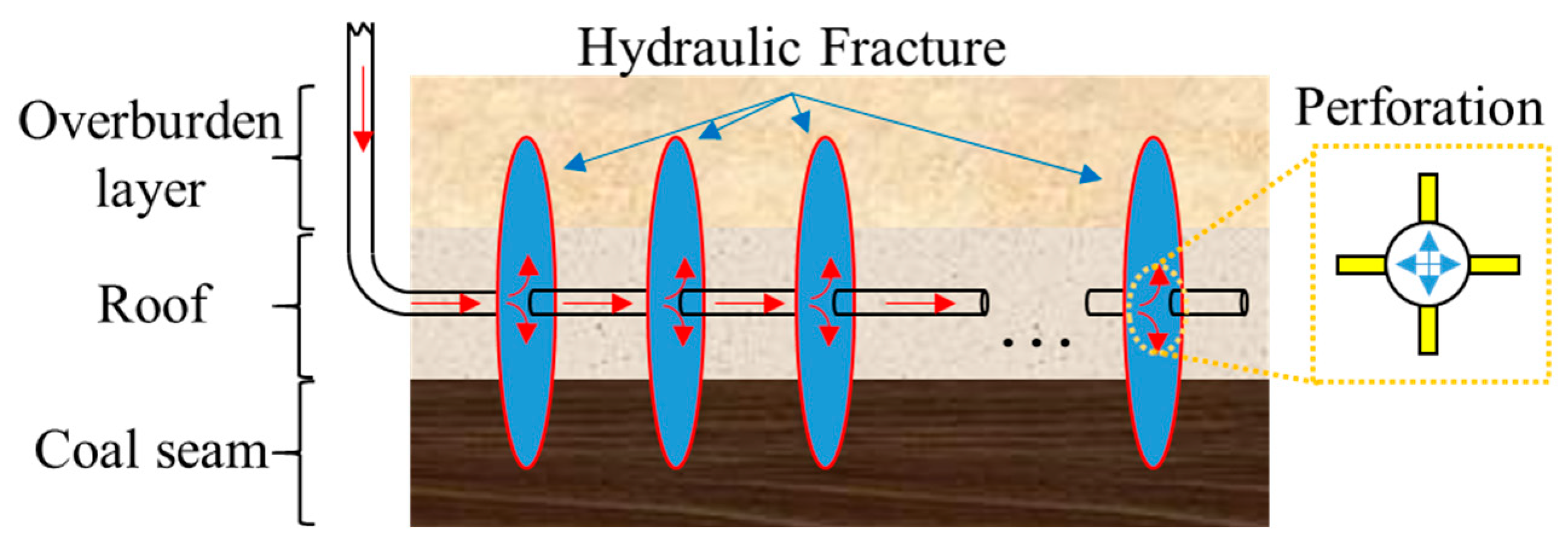
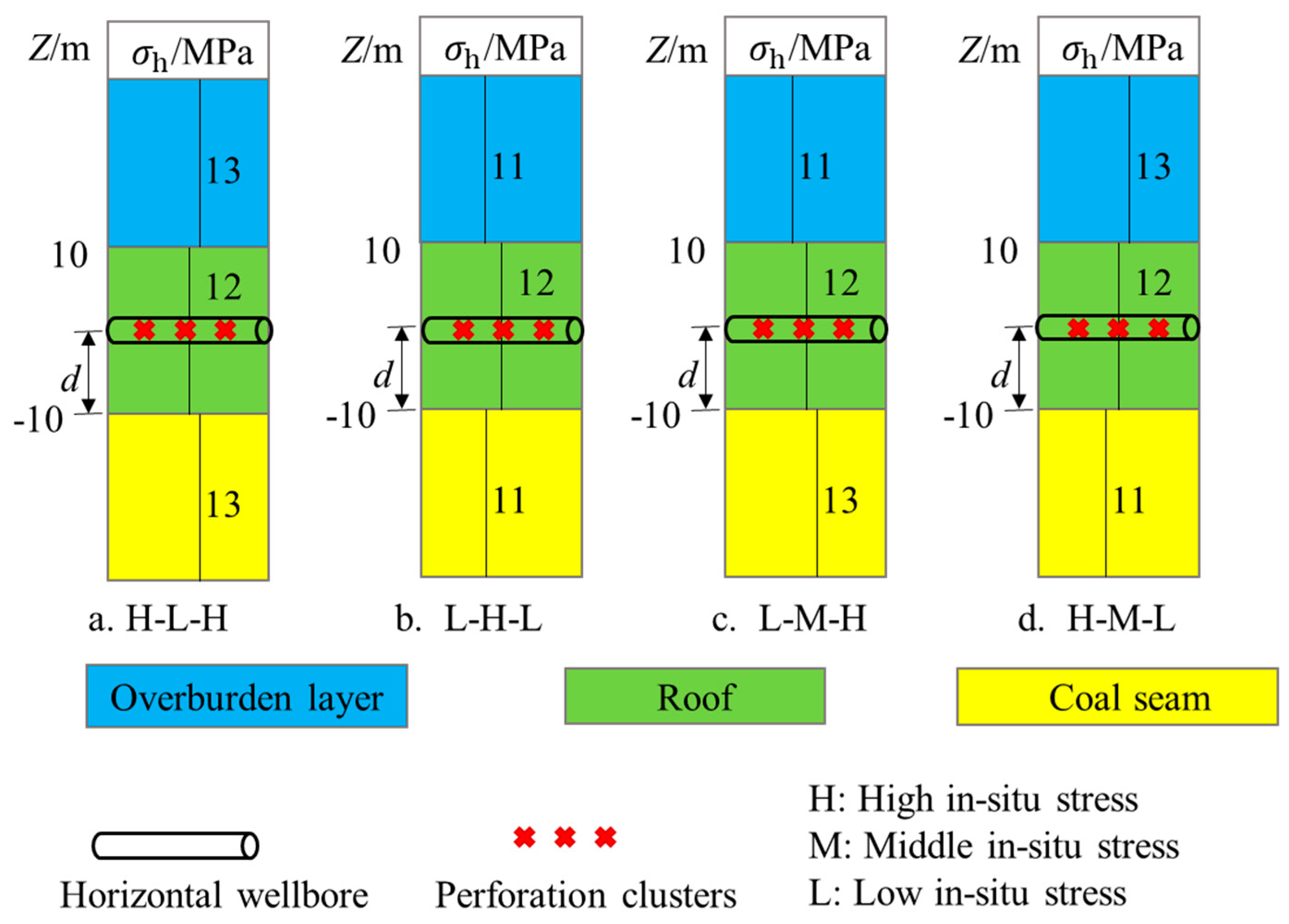

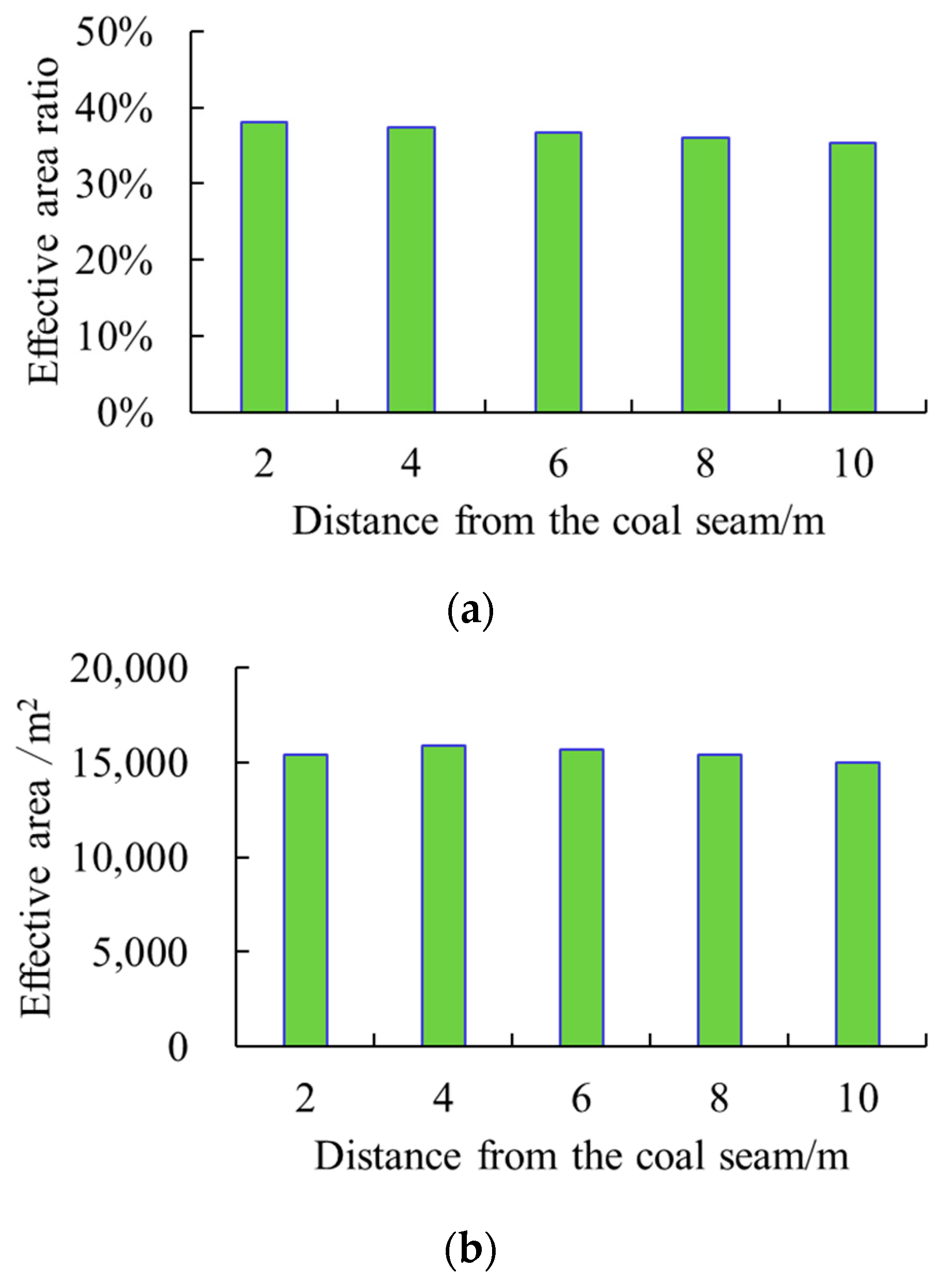
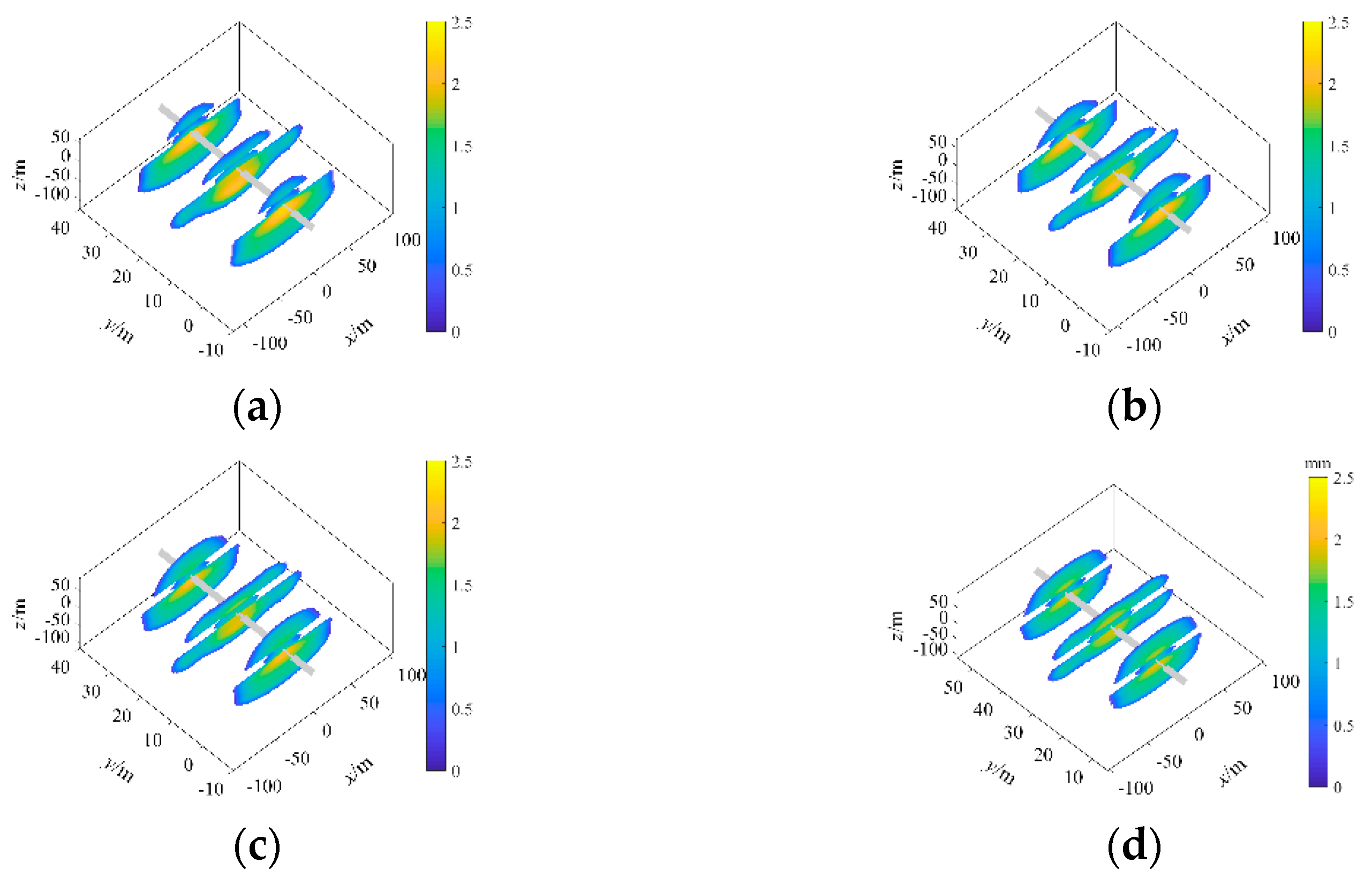

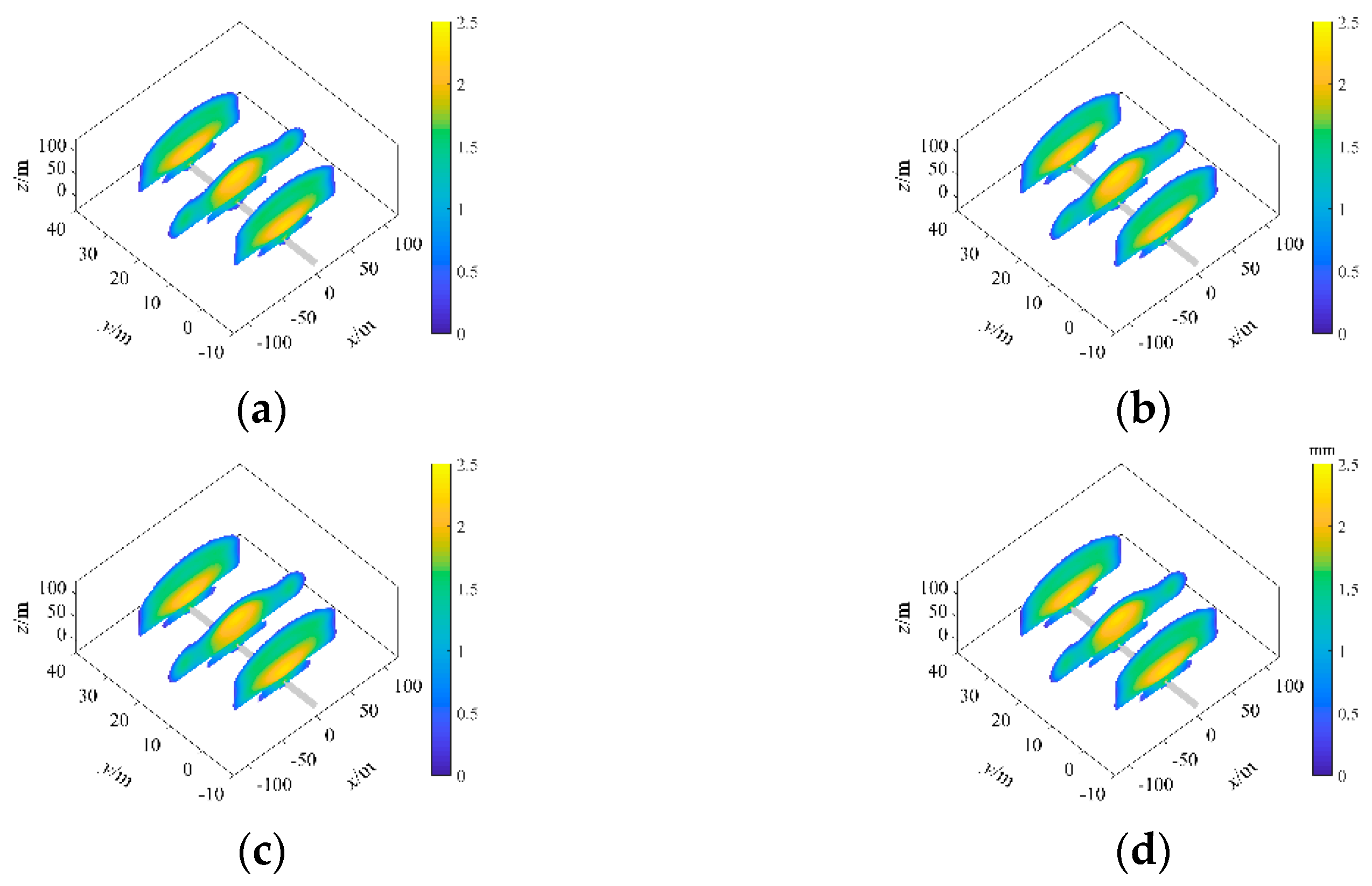


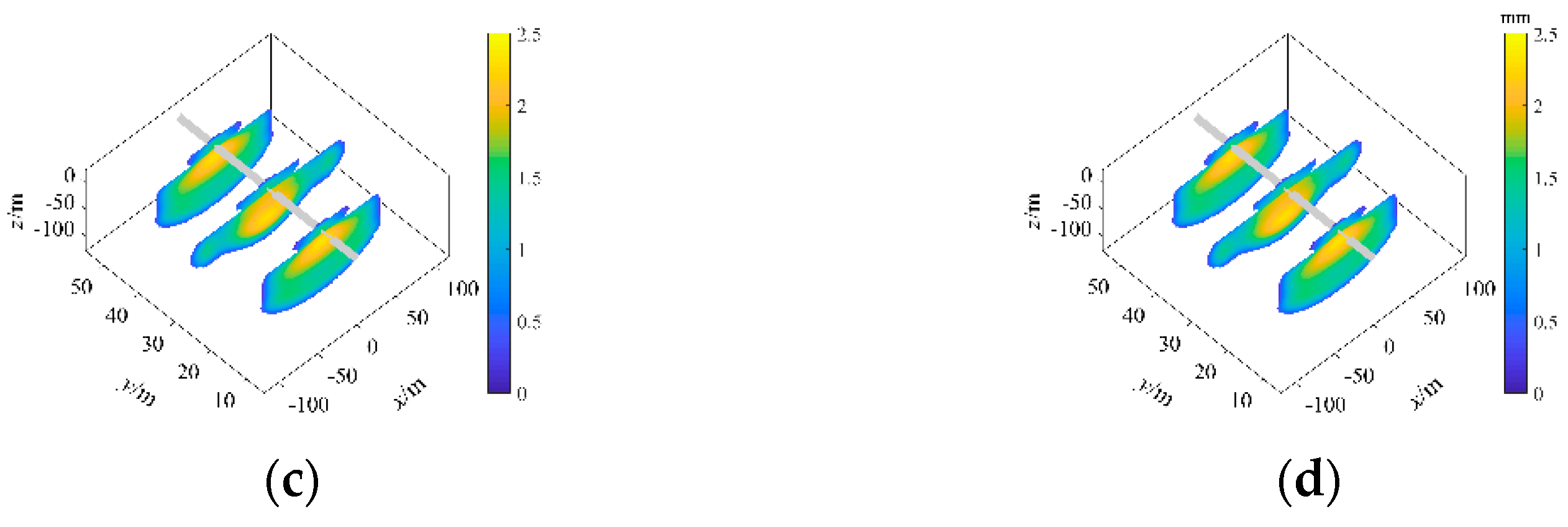
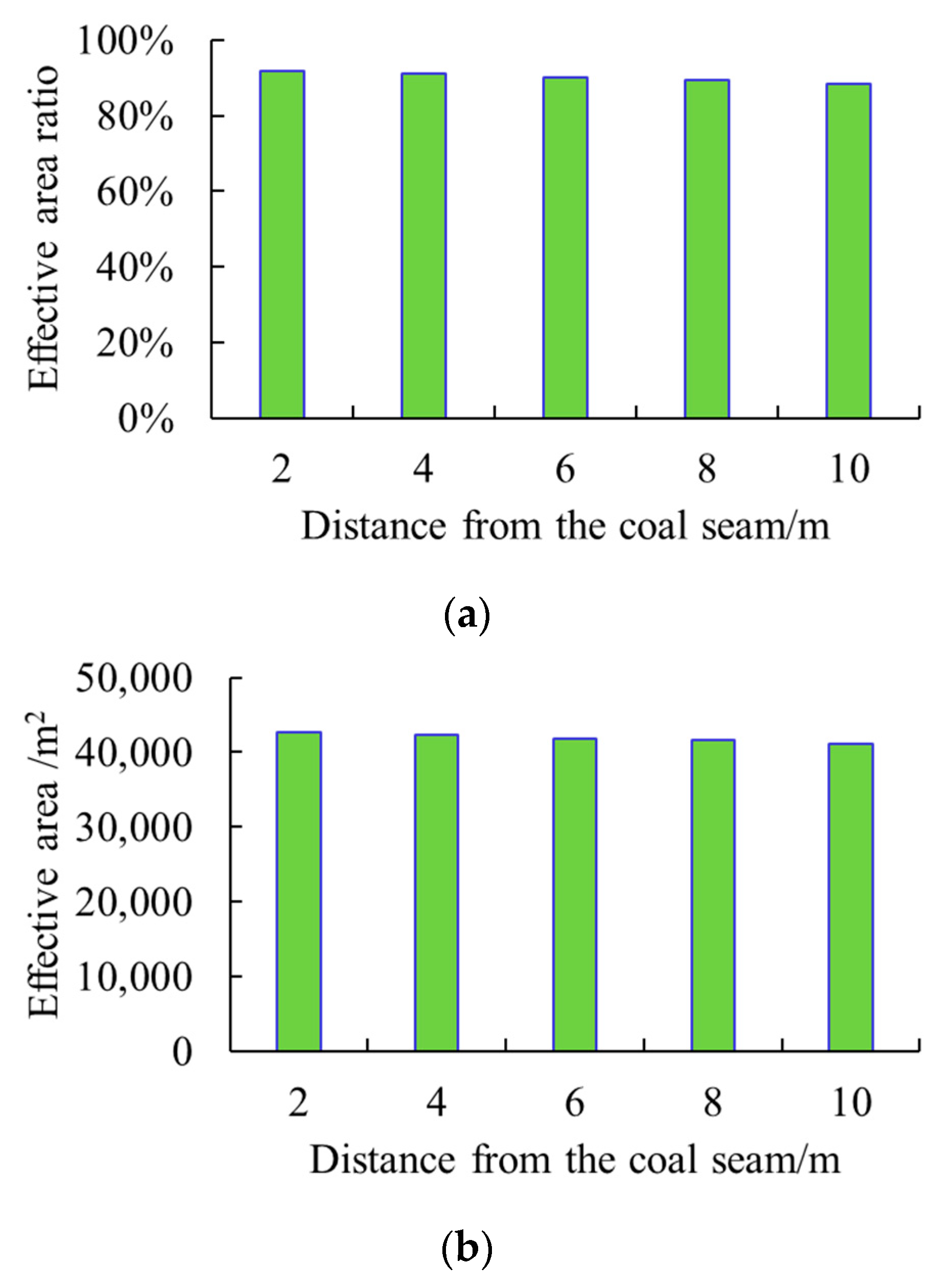
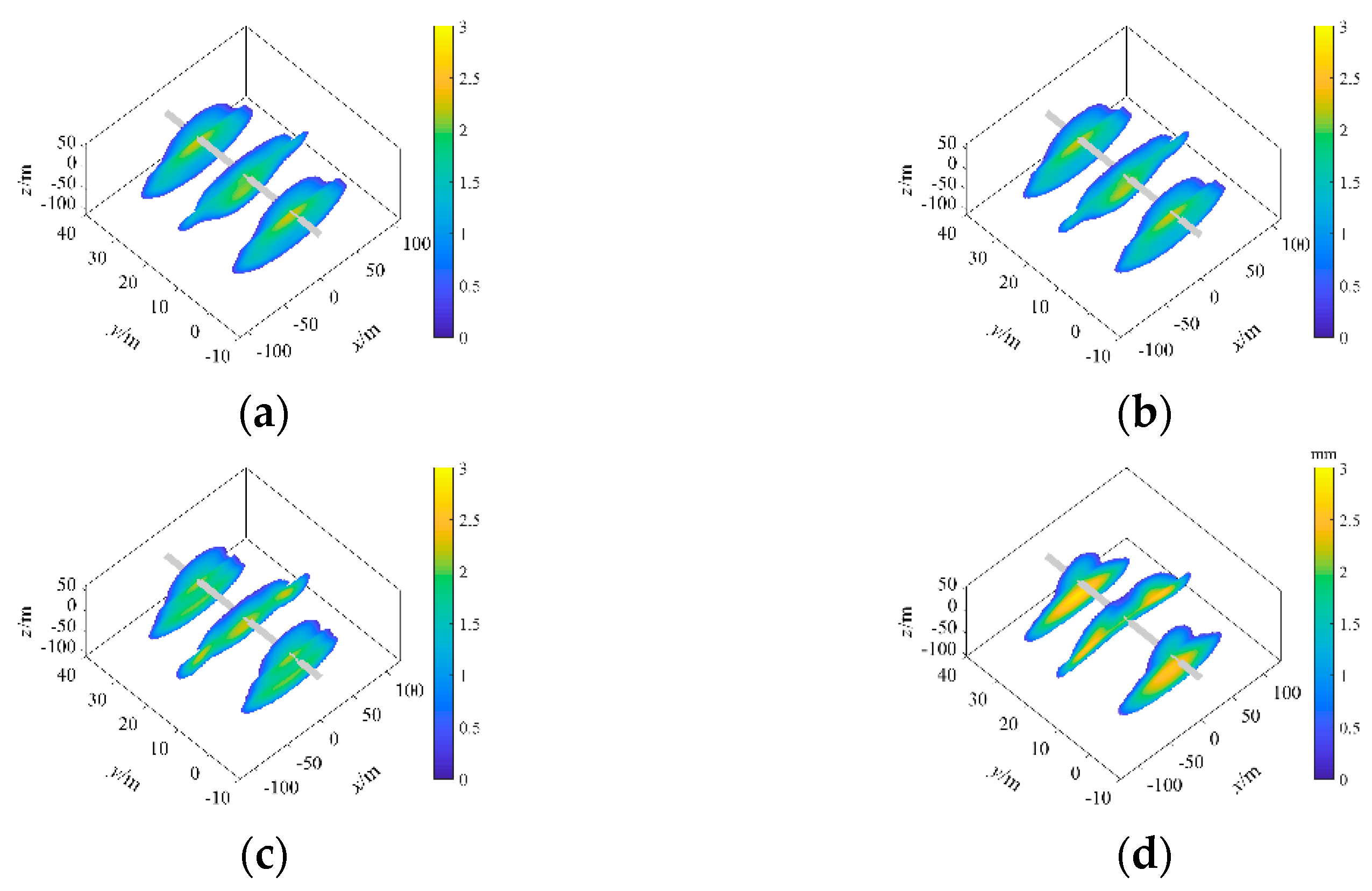
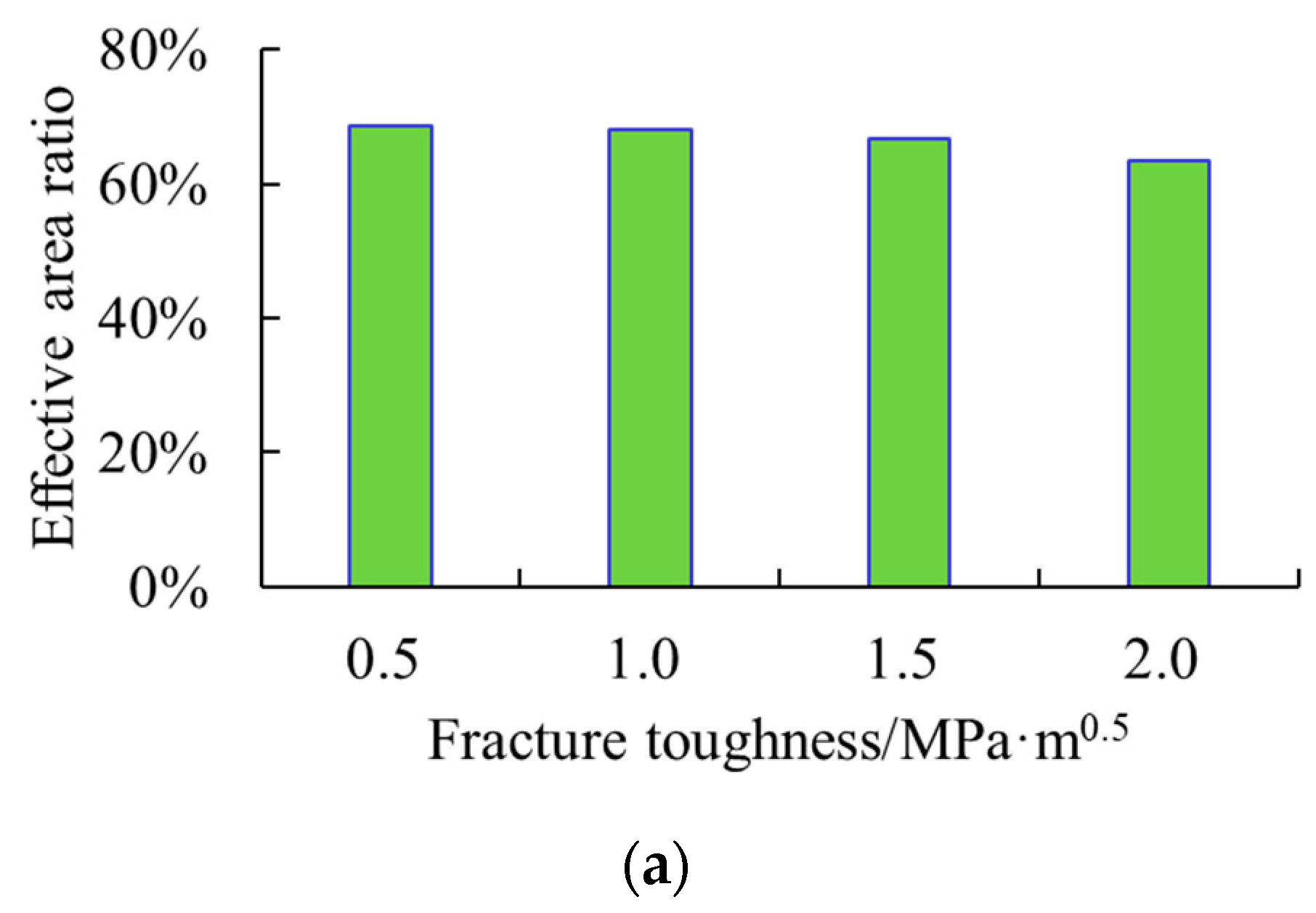
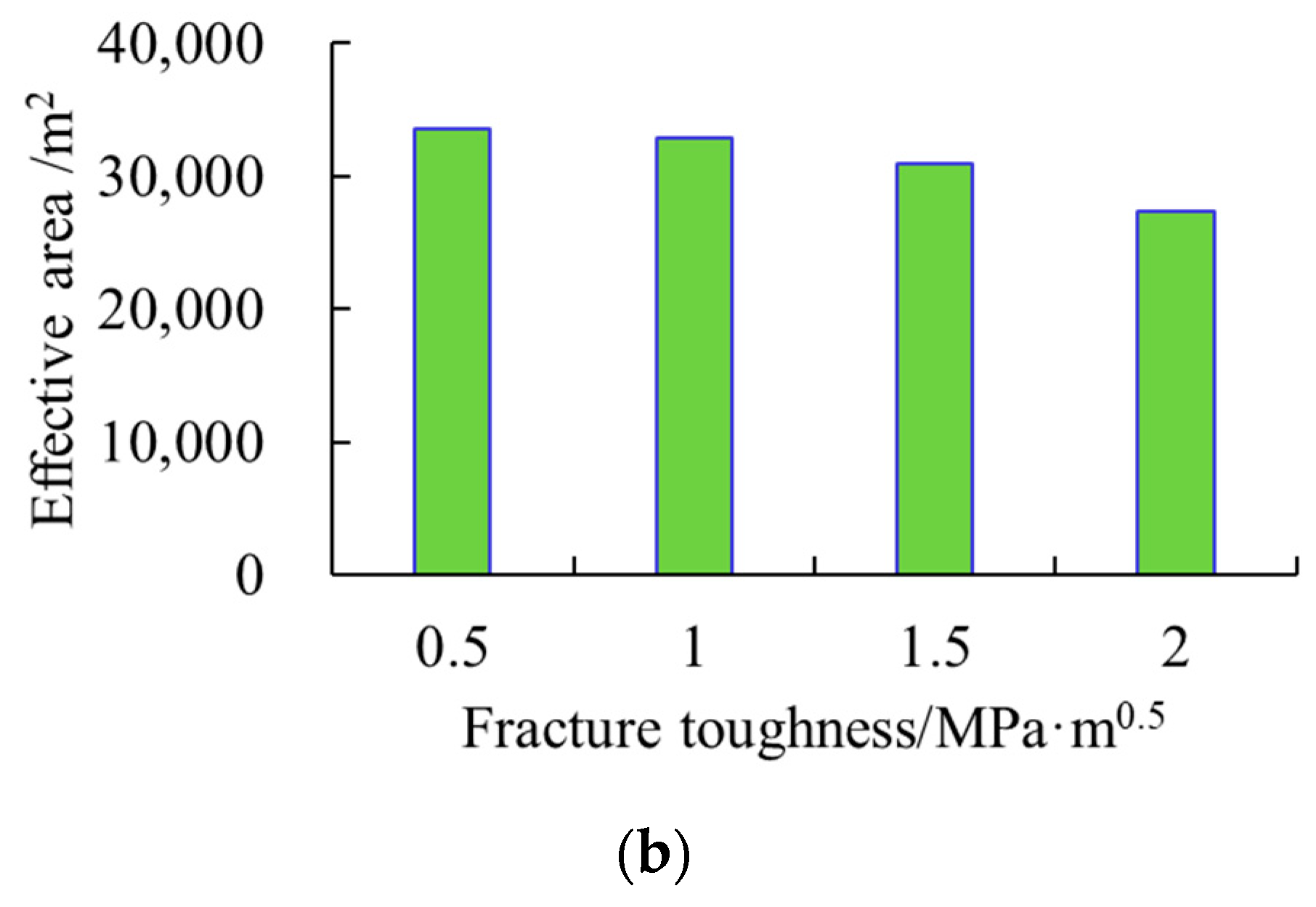



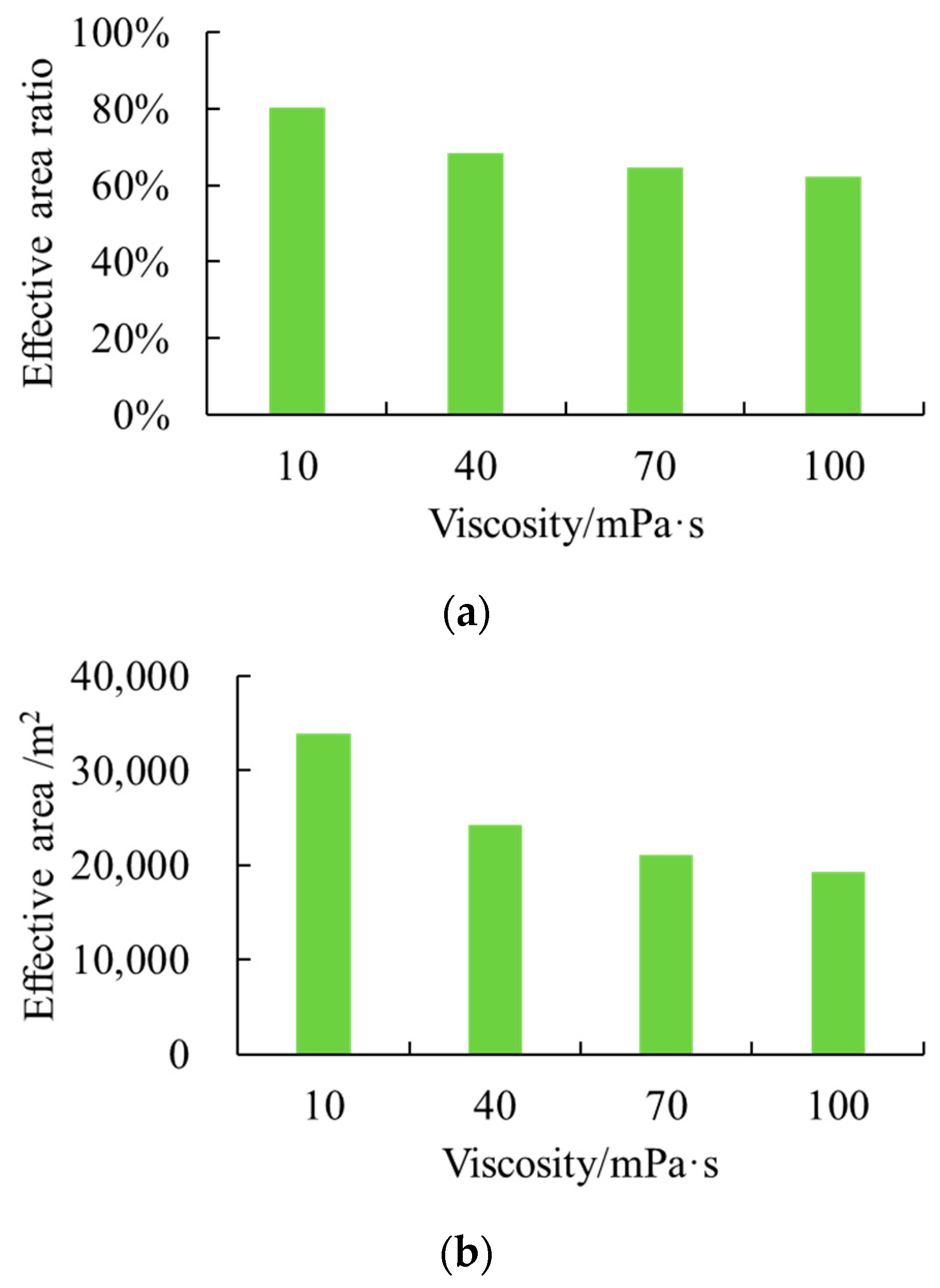

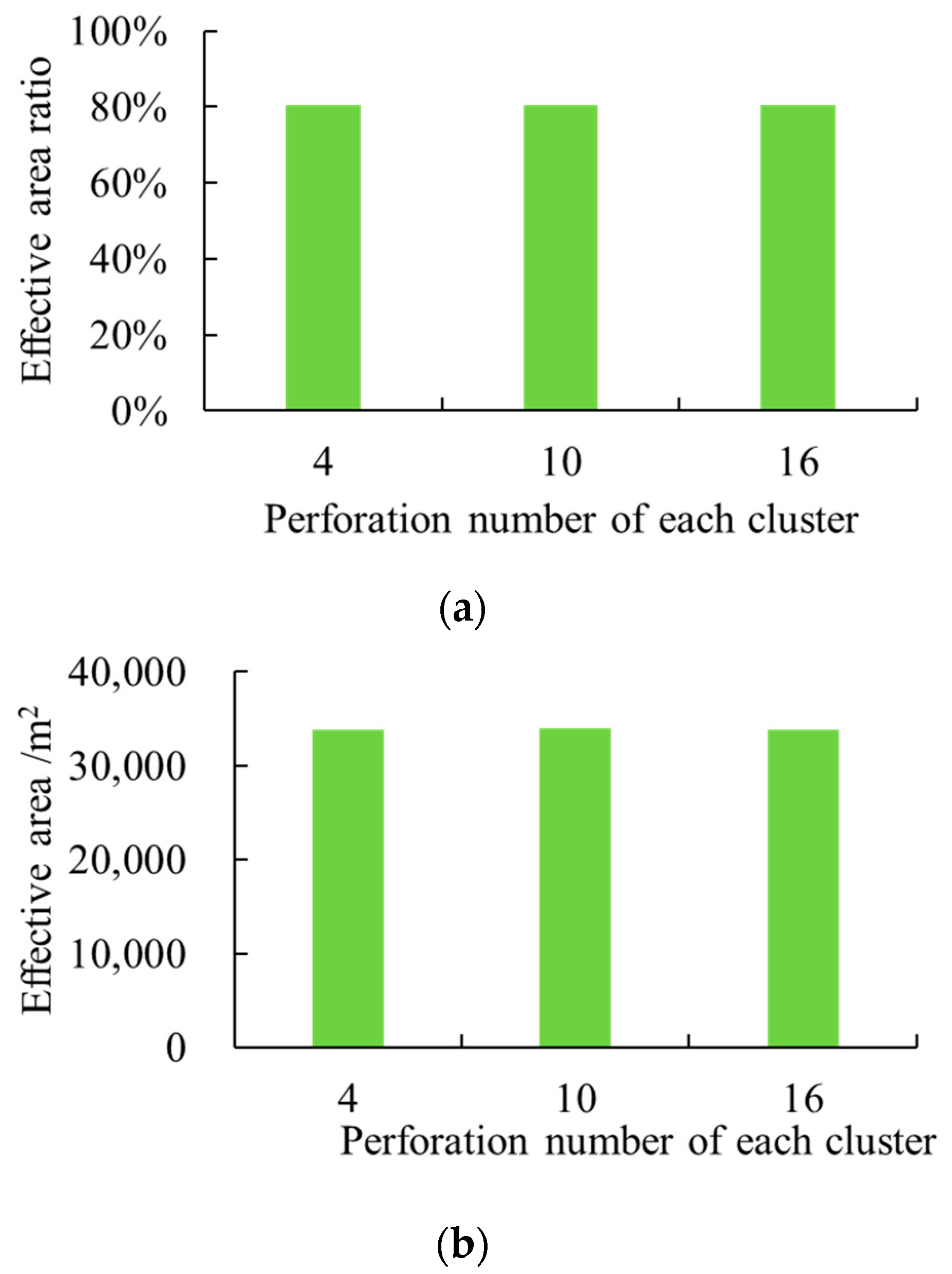
Publisher’s Note: MDPI stays neutral with regard to jurisdictional claims in published maps and institutional affiliations. |
© 2022 by the authors. Licensee MDPI, Basel, Switzerland. This article is an open access article distributed under the terms and conditions of the Creative Commons Attribution (CC BY) license (https://creativecommons.org/licenses/by/4.0/).
Share and Cite
Li, Y.; Xiao, J.; Wang, Y.; Deng, C. Numerical Simulation Investigation on Fracture Propagation of Fracturing for Crossing Coal Seam Roof. Processes 2022, 10, 1296. https://doi.org/10.3390/pr10071296
Li Y, Xiao J, Wang Y, Deng C. Numerical Simulation Investigation on Fracture Propagation of Fracturing for Crossing Coal Seam Roof. Processes. 2022; 10(7):1296. https://doi.org/10.3390/pr10071296
Chicago/Turabian StyleLi, Yanchao, Jianfeng Xiao, Yixuan Wang, and Cai Deng. 2022. "Numerical Simulation Investigation on Fracture Propagation of Fracturing for Crossing Coal Seam Roof" Processes 10, no. 7: 1296. https://doi.org/10.3390/pr10071296




